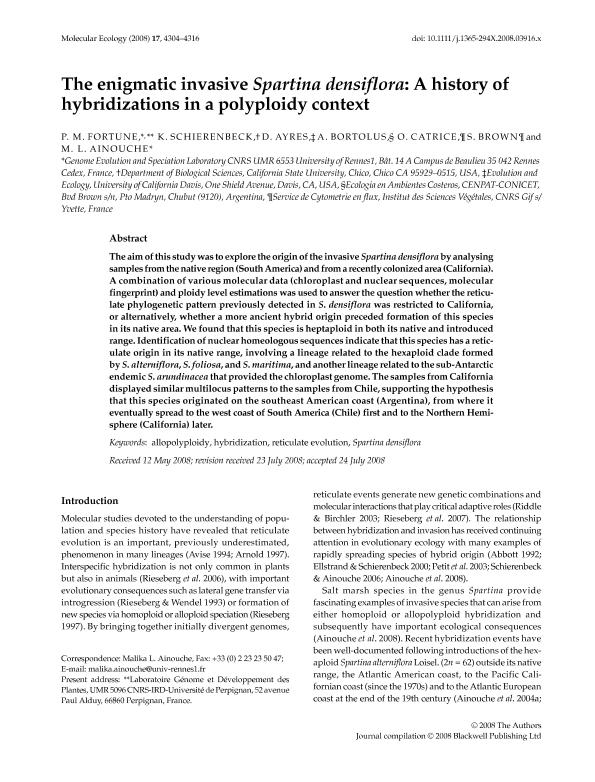Mostrar el registro sencillo del ítem
dc.contributor.author
Fortune, P.M.
dc.contributor.author
Schierenbeck, K.
dc.contributor.author
Ayres, D.
dc.contributor.author
Bortolus, Alejandro

dc.contributor.author
Catrice, O.
dc.contributor.author
Brown, S.
dc.contributor.author
Ainouche, M.L.
dc.date.available
2020-04-23T18:49:33Z
dc.date.issued
2008-12
dc.identifier.citation
Fortune, P.M.; Schierenbeck, K.; Ayres, D.; Bortolus, Alejandro; Catrice, O.; et al.; The enigmatic invasive Spartina densiflora : A history of hybridizations in a polyploidy context; Wiley Blackwell Publishing, Inc; Molecular Ecology; 17; 19; 12-2008; 4304-4316
dc.identifier.issn
0962-1083
dc.identifier.uri
http://hdl.handle.net/11336/103495
dc.description.abstract
The aim of this study was to explore the origin of the invasive Spartina densiflora by analysing samples from the native region (South America) and from a recently colonized area (California). A combination of various molecular data (chloroplast and nuclear sequences, molecular fingerprint) and ploidy level estimations was used to answer the question whether the reticulate phylogenetic pattern previously detected in S. densiflora was restricted to California, or alternatively, whether a more ancient hybrid origin preceded formation of this species in its native area. We found that this species is heptaploid in both its native and introduced range. Identification of nuclear homeologous sequences indicate that this species has a reticulate origin in its native range, involving a lineage related to the hexaploid clade formed by S. alterniflora, S. foliosa, and S. maritima, and another lineage related to the sub‐Antarctic endemic S. arundinacea that provided the chloroplast genome. The samples from California displayed similar multilocus patterns to the samples from Chile, supporting the hypothesis that this species originated on the southeast American coast (Argentina), from where it eventually spread to the west coast of South America (Chile) first and to the Northern Hemisphere (California) later.
dc.format
application/pdf
dc.language.iso
eng
dc.publisher
Wiley Blackwell Publishing, Inc

dc.rights
info:eu-repo/semantics/openAccess
dc.rights.uri
https://creativecommons.org/licenses/by-nc-sa/2.5/ar/
dc.subject
ALLOPOLYPLOIDY
dc.subject
HYBRIDIZATION
dc.subject
RETICULATE EVOLUTION
dc.subject
SPARTINA DENSIFLORA
dc.subject.classification
Ecología

dc.subject.classification
Ciencias Biológicas

dc.subject.classification
CIENCIAS NATURALES Y EXACTAS

dc.title
The enigmatic invasive Spartina densiflora : A history of hybridizations in a polyploidy context
dc.type
info:eu-repo/semantics/article
dc.type
info:ar-repo/semantics/artículo
dc.type
info:eu-repo/semantics/publishedVersion
dc.date.updated
2020-03-16T15:08:50Z
dc.identifier.eissn
1365-294X
dc.journal.volume
17
dc.journal.number
19
dc.journal.pagination
4304-4316
dc.journal.pais
Reino Unido

dc.journal.ciudad
Londres
dc.description.fil
Fil: Fortune, P.M.. Universite de Rennes I; Francia
dc.description.fil
Fil: Schierenbeck, K.. California State University; Estados Unidos
dc.description.fil
Fil: Ayres, D.. California State University; Estados Unidos
dc.description.fil
Fil: Bortolus, Alejandro. Consejo Nacional de Investigaciones Científicas y Técnicas. Centro Científico Tecnológico Conicet - Centro Nacional Patagónico; Argentina
dc.description.fil
Fil: Catrice, O.. Institut des Sciences Végétales; Francia
dc.description.fil
Fil: Brown, S.. Institut des Sciences Végétales; Francia
dc.description.fil
Fil: Ainouche, M.L.. Universite de Rennes I; Francia
dc.journal.title
Molecular Ecology
dc.relation.alternativeid
info:eu-repo/semantics/altIdentifier/url/https://onlinelibrary.wiley.com/doi/abs/10.1111/j.1365-294X.2008.03916.x
dc.relation.alternativeid
info:eu-repo/semantics/altIdentifier/doi/https://doi.org/10.1111/j.1365-294X.2008.03916.x
Archivos asociados
